The ronin samurai represents something deeply profound in Japanese culture – a warrior without a master, wandering the landscape with nothing but his blade and his honor. These masterless warriors have captured imaginations for centuries, and their powerful imagery translates beautifully into tattoo art. There’s something about the solitary nature of the ronin that speaks to modern souls, maybe because we all feel a bit masterless sometimes in this chaotic world.
Unlike their lord-serving counterparts, ronin samurai lived by their own code. They were free but also burdened by that freedom. This duality makes them perfect subjects for tattoo designs that carry deep personal meaning. When you’re considering a ronin tattoo, you’re not just getting ink – you’re embracing a philosophy of self-reliance and inner strength.
The Essence of Ronin Symbolism
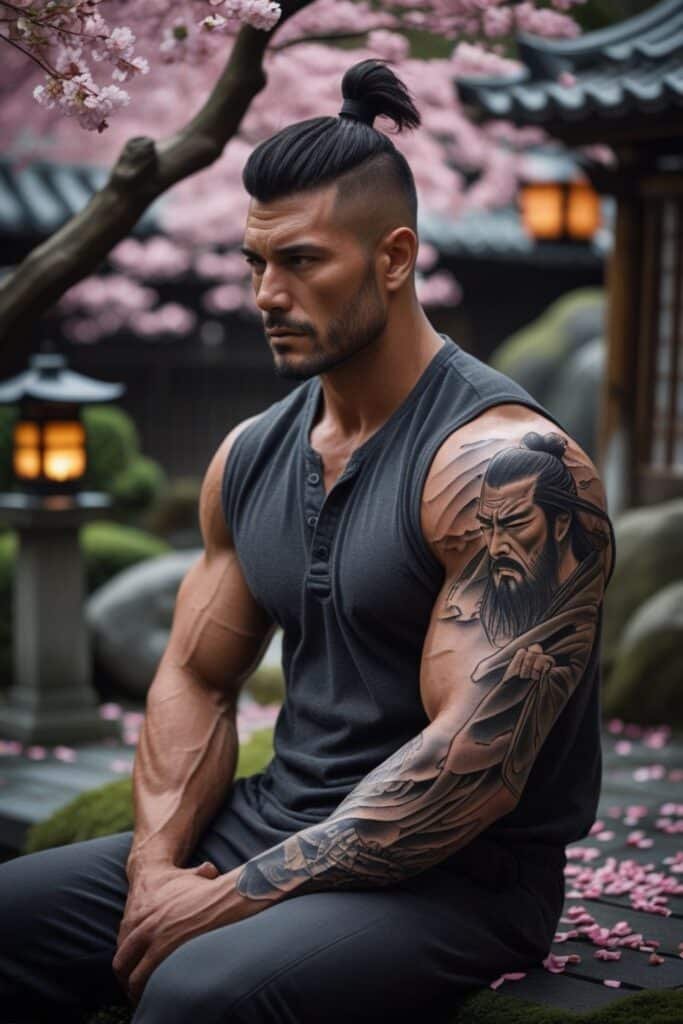
The word “ronin” literally means “wave man” in Japanese, suggesting someone who drifts like waves on the ocean. This metaphor runs deeper than most people realize. These warriors were often seen as both tragic and noble figures, caught between loyalty to their fallen masters and the harsh realities of survival. Their stories resonate because they represent the universal human struggle against fate and circumstance.
Traditional ronin imagery often features weathered faces, tattered clothing, and weapons that have seen countless battles. The aesthetic isn’t about perfection or pristine armor – it’s about authenticity and the marks that life leaves on us. A well-designed ronin tattoo captures this weathered wisdom, showing a warrior who has faced adversity and emerged stronger, albeit scarred.
The cherry blossom connection is particularly powerful in ronin tattoos. These flowers bloom briefly and beautifully before falling, much like the ronin’s fleeting moments of purpose between long periods of wandering. Many tattoo artists incorporate sakura petals falling around the ronin figure, creating a poetic contrast between the warrior’s strength and life’s fragility.
Classic Ronin Tattoo Compositions

The full-back ronin piece remains one of the most dramatic tattoo concepts you can choose. Picture a lone warrior standing on a cliff overlooking a vast landscape, his katana resting against his shoulder. The composition allows for incredible detail – from the intricate patterns on his clothing to the subtle expressions of determination and melancholy on his face. These pieces often take multiple sessions to complete, but the result is nothing short of breathtaking.
Sleeve designs offer another compelling approach to ronin tattoos. Starting from the shoulder, you might have the ronin’s face in profile, with his story unfolding down the arm. Perhaps bamboo forests transition into urban landscapes, representing the ronin’s journey through different worlds. The beauty of sleeve tattoos is their narrative quality – each viewing angle reveals new details and elements of the story.
Chest pieces work particularly well for ronin concepts because they sit close to the heart. A ronin kneeling in meditation, perhaps beside a grave or ancestral shrine, creates a powerful statement about honor and remembrance. The chest placement makes these tattoos feel more personal and intimate, like carrying the warrior’s spirit within yourself.
Modern Interpretations and Fusion Styles
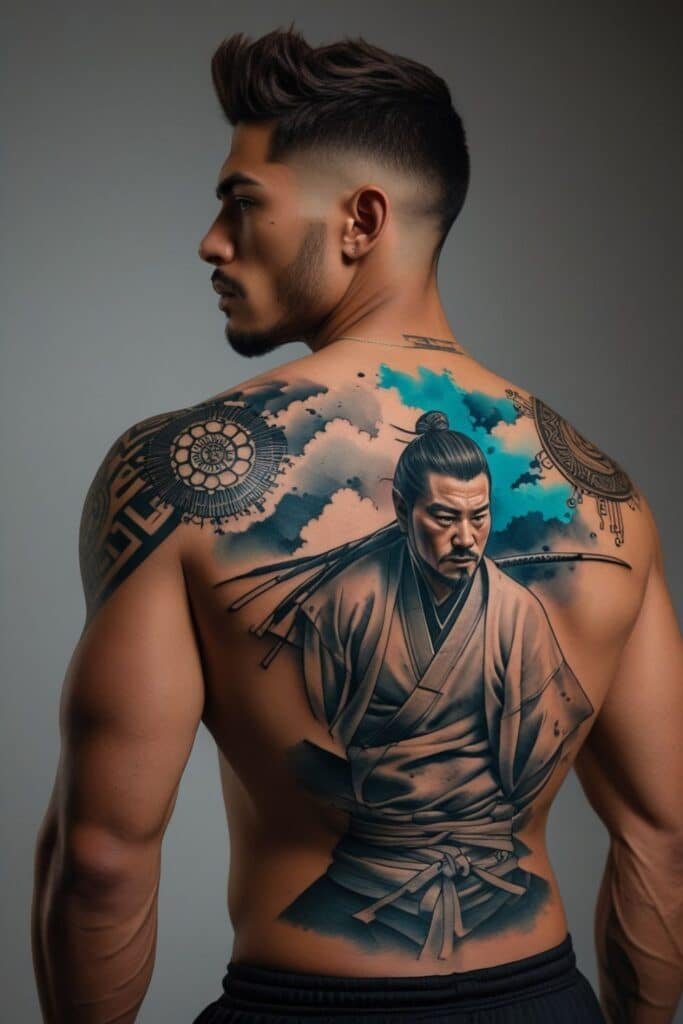
Contemporary tattoo artists are pushing ronin imagery in exciting new directions. Some blend traditional Japanese aesthetics with modern urban elements, creating ronin who navigate both ancient feudal Japan and contemporary cityscapes. These fusion pieces might show a ronin walking through neon-lit streets, his traditional garb contrasting with modern architecture. It’s a powerful metaphor for feeling displaced in our own time.
Neo-traditional styles add bold colors and slightly exaggerated features to ronin designs. Think deeper blues in the clothing, more dramatic shadows, and perhaps supernatural elements like ghostly flames or ethereal mist. These modifications don’t abandon the traditional essence but enhance it with contemporary tattoo techniques. The result is often more visually striking while maintaining the spiritual depth of the original concept.
Some artists experiment with geometric patterns integrated into ronin tattoos. Sacred geometry might frame the warrior, or his clothing could incorporate mandala-like designs. This approach bridges Eastern and Western spiritual traditions, creating tattoos that speak to universal themes of balance and harmony. It’s particularly appealing to people who appreciate both Japanese culture and modern artistic movements.
Color Palettes and Their Significance
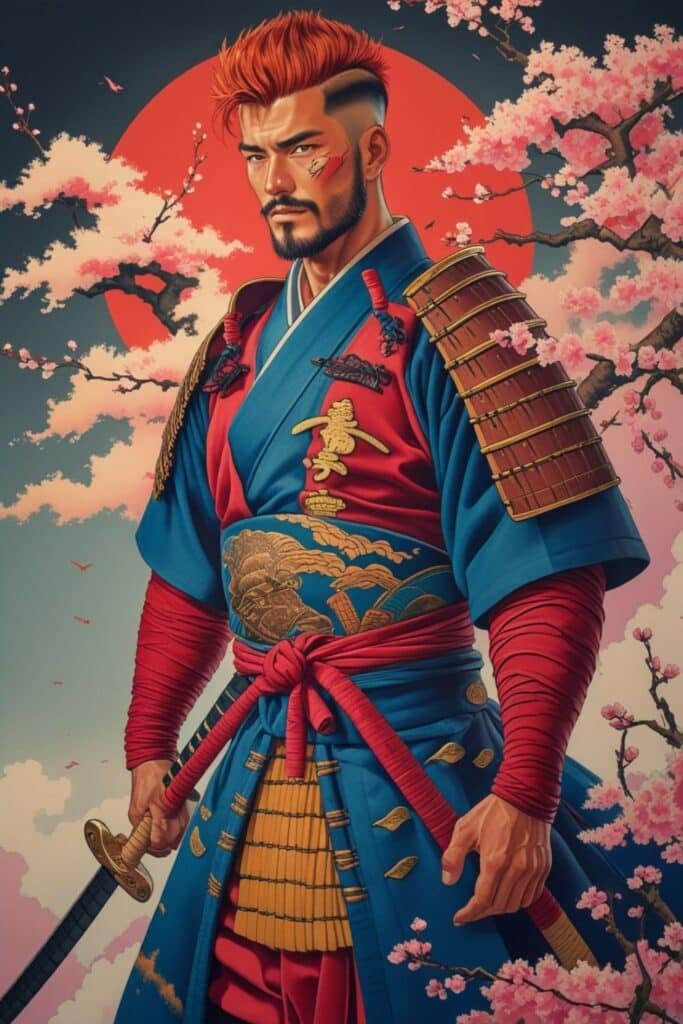
Traditional black and gray ronin tattoos possess an timeless elegance that’s hard to match. The monochromatic approach emphasizes form, shadow, and texture over flashy colors. These tattoos age beautifully and maintain their impact for decades. There’s something about black and gray that feels more authentic to the ronin’s austere lifestyle – no unnecessary embellishments, just pure artistic expression.
When color is introduced, it’s usually done sparingly and with purpose. Deep crimson might accent the warrior’s clothing or the grip of his sword. Muted golds can highlight important details like family crests or ceremonial elements. The key is restraint – too much color can overwhelm the design’s contemplative nature.
Blue and purple tones work exceptionally well for creating atmospheric effects in ronin tattoos. These colors can suggest twilight scenes, adding emotional depth to the piece. A ronin silhouetted against a purple-blue sky creates a sense of solitude and introspection that perfectly captures the character’s essence. Many people find these cooler tones more personally meaningful than warmer palettes.
Placement Considerations for Maximum Impact

The back offers the most canvas space for elaborate ronin scenes. Full-back pieces can include extensive landscapes, multiple figures, or complex architectural elements. You might feature the ronin in different seasons or life stages, creating a visual autobiography. The back’s flat surface also allows for better preservation of fine details over time, making it ideal for pieces with intricate linework.
Arm placements provide excellent visibility and conversation-starting potential. A ronin portrait on the upper arm can be easily shown or concealed depending on clothing choices. Lower arm placements work well for action scenes – perhaps the ronin drawing his sword or in mid-combat. The arm’s natural curves can enhance the dynamic flow of the composition.
Leg tattoos offer unique opportunities for ronin imagery. A calf piece might show the ronin’s journey literally unfolding as he walks, with each step revealing new elements of his story. Thigh placements provide substantial space for detailed scenes while remaining easily concealable in professional settings. The leg’s length allows for vertical compositions that can be particularly striking.
Incorporating Personal Elements
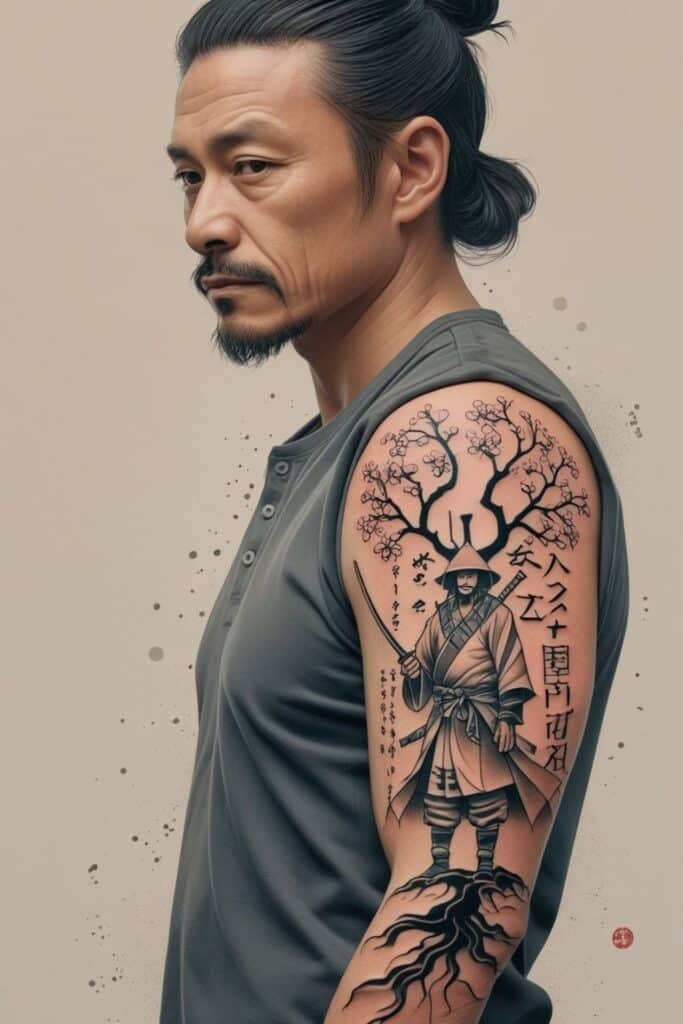
Many people choose to personalize their ronin tattoos with elements that reflect their own journey. Family crests, important dates, or meaningful symbols can be woven into the design without compromising its authentic feel. A ronin might be shown visiting a grave with your loved one’s name, or carrying a banner with your family’s insignia. These personal touches transform the tattoo from beautiful art into meaningful memoir.
Some individuals incorporate modern elements that represent their own “masterless” periods – perhaps corporate logos from companies they’ve left, or symbols representing career changes. A ronin walking away from burning bridges (literally or metaphorically) can represent personal transformation and the courage to forge new paths. These contemporary interpretations maintain the ronin’s spirit while making the design uniquely yours.
Pet memorials work surprisingly well in ronin tattoos. A loyal dog or cat companion traveling alongside the ronin can represent the bond between master and faithful friend. This addition doesn’t diminish the tattoo’s power but adds layers of personal meaning. Animals in Japanese art often symbolize specific virtues, so research the traditional meanings to ensure your addition enhances the overall symbolism.
Working with Skilled Artists
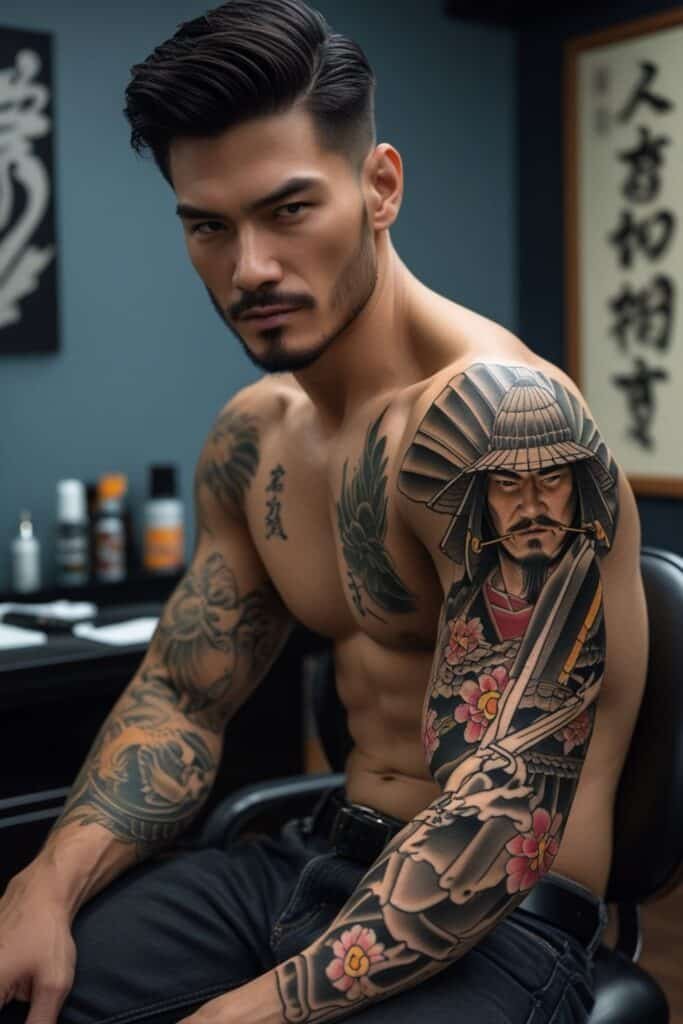
Finding the right tattoo artist for your ronin piece is crucial. Look for artists who specialize in Japanese traditional or neo-traditional styles, as they’ll understand the cultural nuances and artistic techniques required. Study their portfolio carefully – pay attention to how they handle fabric textures, facial expressions, and atmospheric effects. The best ronin tattoos require an artist who can capture both technical skill and emotional depth.
Communication with your artist is essential for achieving your vision. Bring reference images, but also be prepared to discuss the emotional significance you want the tattoo to convey. Is your ronin stoic and determined, or melancholy and reflective? These subtle differences in expression can dramatically change the tattoo’s impact. Don’t hesitate to ask for preliminary sketches or digital mockups before committing to the final design.
Consider the long-term relationship you’ll have with your tattoo artist if you’re planning a large piece. Multi-session tattoos require consistency in style and technique, so choose someone whose artistic vision aligns with yours. The best ronin tattoos often evolve during the tattooing process, with artist and client collaborating to refine details and enhance the overall composition.
Cultural Respect and Authenticity
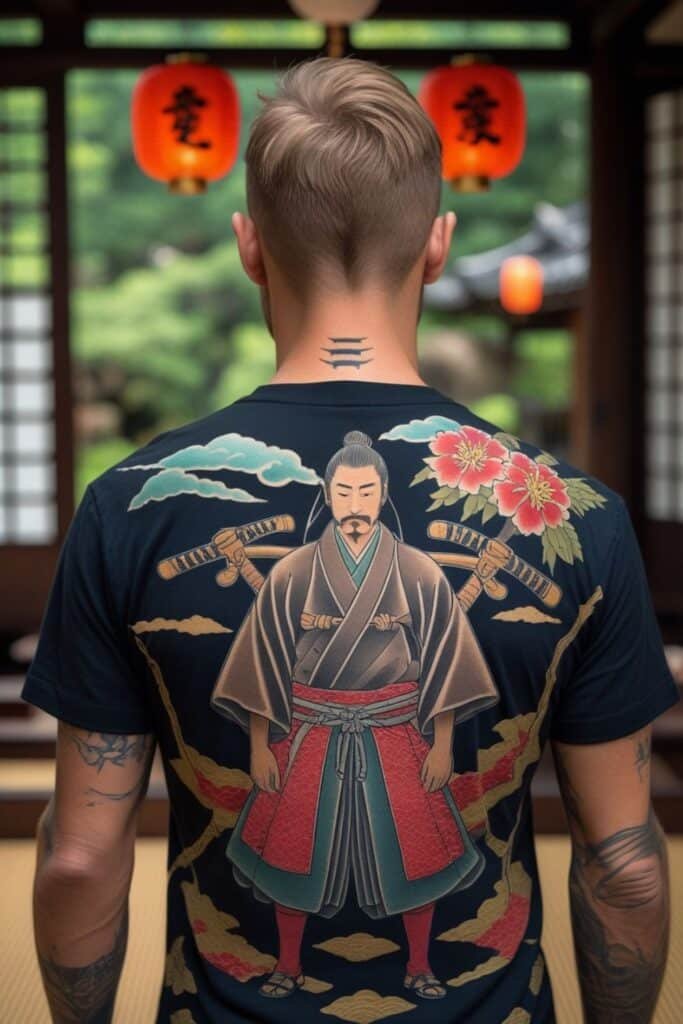
When choosing a ronin tattoo, it’s important to approach the subject with respect for Japanese culture and history. These weren’t just fictional characters – they were real people who lived complex lives during turbulent times. Research the historical context and understand what the ronin represented in their society. This knowledge will help you make informed decisions about your tattoo’s design and ensure it honors rather than trivializes the source material.
Avoid mixing incompatible cultural elements or using imagery that might be considered inappropriate. For example, combining ronin imagery with symbols from other cultures can create confusion or unintended offense. Stick to authentic Japanese artistic traditions or work with your artist to create respectful modern interpretations. The goal is to create something that honors the ronin’s legacy while expressing your personal connection to their story.
Consider learning about the specific historical period or legendary figures that inspire your tattoo. Many famous ronin have documented stories that could inform your design choices. Miyamoto Musashi, perhaps the most famous ronin, developed his own philosophy of swordsmanship that emphasizes adaptability and self-reliance. Understanding these historical figures can add depth and authenticity to your tattoo concept.
Maintenance and Longevity
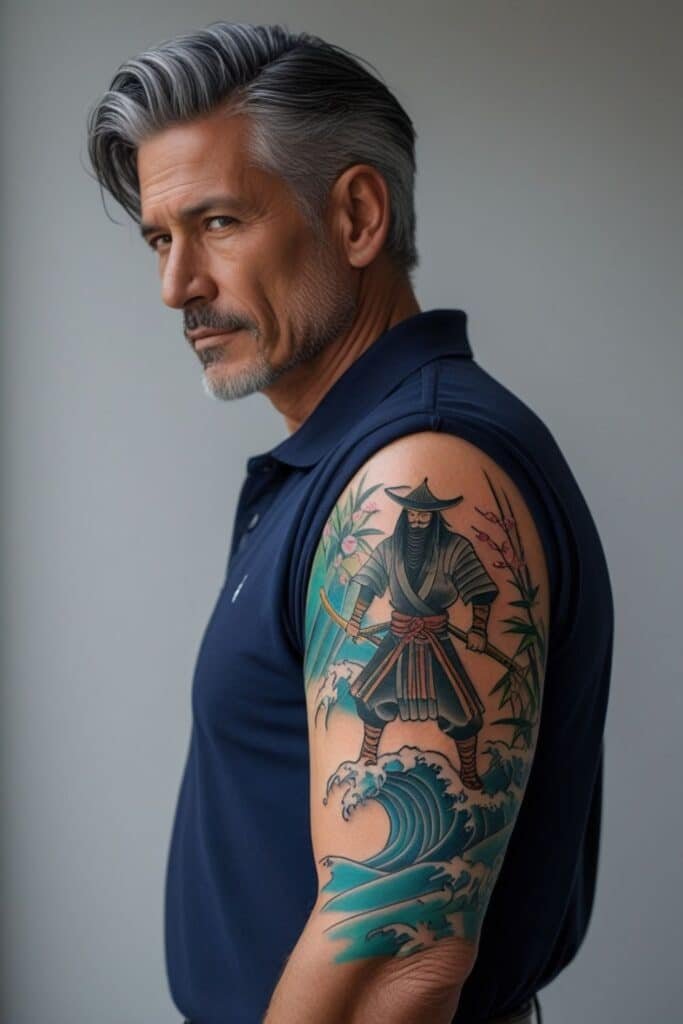
Ronin tattoos, especially large detailed pieces, require proper care to maintain their visual impact over time. The intricate linework and shading typical of these designs need protection from sun exposure and proper moisturization. Japanese-style tattoos generally age well due to their bold design elements and strategic use of black ink, but neglecting aftercare can cause premature fading or blurring.
Regular touch-ups may be necessary to maintain fine details, particularly in facial features and textile textures. Plan for this ongoing maintenance when budgeting for your tattoo. Many artists offer touch-up services at reduced rates for their original work, so discuss this possibility when choosing your artist. The investment in proper maintenance ensures your ronin tattoo remains as powerful and meaningful as the day it was completed.
Consider how your tattoo might age along with your body. Placement on areas that experience significant weight fluctuation or muscle development can affect the tattoo’s appearance over time. Discuss these concerns with your artist during the planning phase – they can suggest design modifications or placement adjustments that will help your tattoo age gracefully.
The Spiritual Dimension
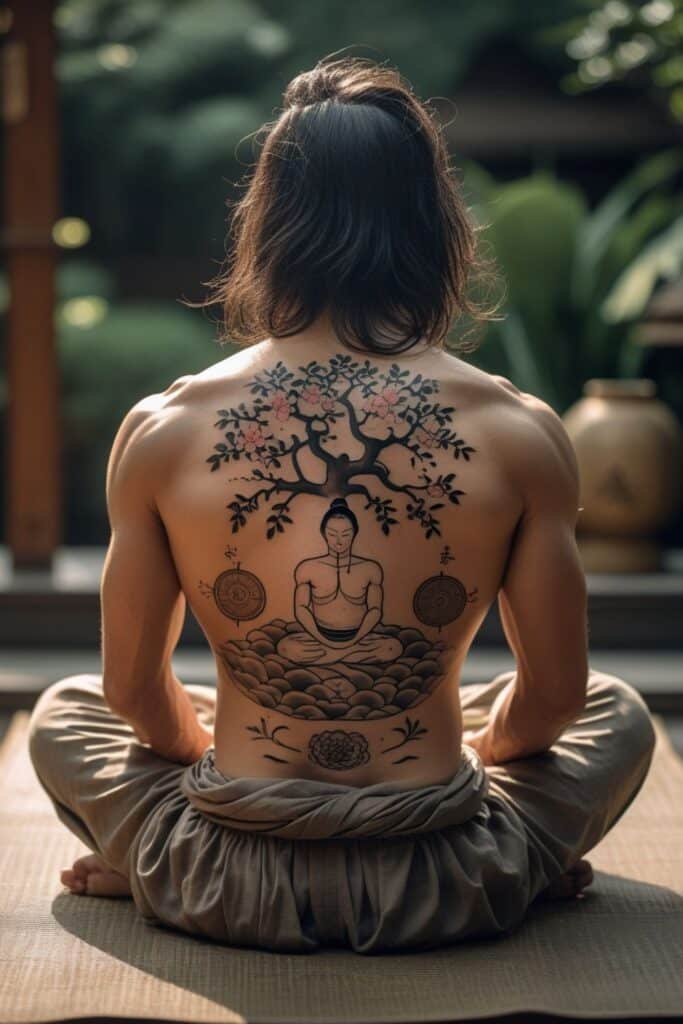
For many people, ronin tattoos represent more than just aesthetic choices – they’re spiritual statements about independence, resilience, and personal growth. The ronin’s journey mirrors our own struggles with identity, purpose, and belonging. Getting a ronin tattoo can mark a significant life transition or serve as a reminder of your own inner strength during difficult times.
The meditation aspects of ronin culture often appeal to modern tattoo enthusiasts. Many ronin were practitioners of Zen Buddhism, finding peace and clarity through disciplined practice. Your tattoo might incorporate elements of this spiritual tradition – perhaps showing the ronin in meditation pose or surrounded by symbols of enlightenment. These additions can transform your tattoo into a daily reminder of your own spiritual journey.
Some people view their ronin tattoos as protective talismans, carrying the warrior’s strength and wisdom with them always. This belief isn’t uncommon in tattoo culture, where meaningful images are thought to influence the wearer’s life path. Whether you embrace this mystical aspect or simply appreciate the symbolism, a well-designed ronin tattoo can serve as a powerful personal totem.
The ronin samurai tattoo represents far more than beautiful artwork – it’s a statement about embracing life’s uncertainties with grace and determination. These masterless warriors continue to inspire us centuries after their historical period ended, proving that some symbols transcend time and culture. Whether you choose a traditional design or modern interpretation, your ronin tattoo will carry the weight of history and the promise of personal transformation.
In our modern world of constant change and uncertainty, the ronin’s example becomes increasingly relevant. We’re all wandering warriors in our own way, seeking purpose and meaning in an unpredictable landscape. A ronin tattoo doesn’t just commemorate these legendary figures – it declares your own commitment to honor, resilience, and self-determination. That’s a legacy worth wearing with pride.

Lex memn is a passionate tattoo artist and writer with 3 years of experience in the tattoo world. Dedicated to inspiring and guiding people through creative designs and meaningful tattoo ideas, Lex memn shares their expertise with readers. Explore their work and passion for ink at TifoMags!

